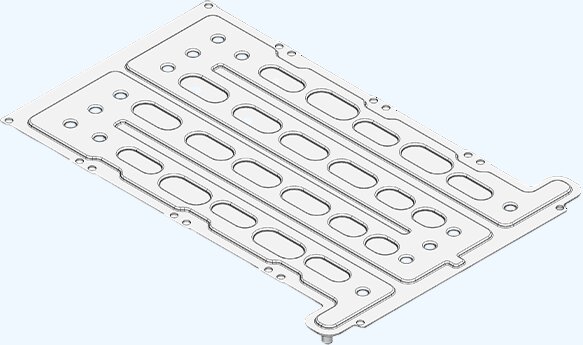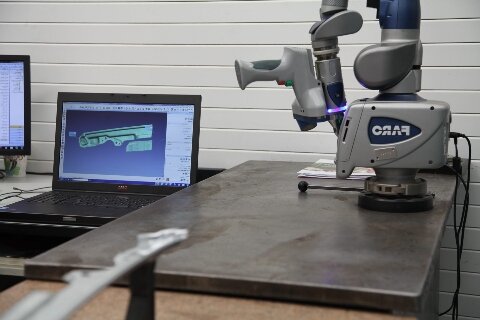최신 제품 디자인은 종종 타이트한 구부림, 깔끔한 마감, 높은 반복성을 요구합니다. 하지만 모든 벤딩 방법이 이러한 요구 사항을 충족할 수 있는 것은 아닙니다. 프레스 브레이크 성형이 해결책이 될 수 있습니다. 정밀한 제어가 가능하고 다양한 금속에 사용할 수 있으며 소량 및 대량 생산에 적합합니다.
프레스 브레이크 성형은 간단해 보이지만 그 이상의 의미가 있습니다. 계속 읽어보면서 어떻게 작동하고 프로젝트에 왜 중요한지 알아보세요.
프레스 브레이크 성형이란 무엇입니까?
프레스 브레이크 성형은 판금을 펀치와 다이 사이에서 눌러서 구부리는 공정입니다. 펀치가 아래로 이동하여 금속을 다이 안으로 밀어 넣어 구부러지게 만듭니다. 각도와 모양은 펀치, 다이, 프레스 깊이에 따라 달라집니다.
프레스 브레이크 성형의 핵심 아이디어는 제어된 힘입니다. 프레스 브레이크는 직선 축을 따라 압력을 가합니다. 이 힘은 금속을 자르거나 부러뜨리지 않고 구부립니다.
굽힘 각도는 펀치가 다이로 얼마나 멀리 이동하는지에 따라 달라집니다. 재료 유형, 두께 및 너비도 결과에 영향을 미칩니다. 작업자는 더 나은 정확도를 위해 힘, 속도 및 위치를 조정할 수 있습니다.
프레스 브레이크의 주요 구성 요소
프레스 브레이크에는 몇 가지 주요 부품이 있습니다:
- 액자: 모든 것을 제자리에 고정하는 몸체.
- 램(또는 슬라이드): 위아래로 움직여 펀치를 주사위에 누릅니다.
- 펀치: 금속 모양을 만드는 상단 도구.
- 주사위: 구부러진 부분을 지지하는 하단 도구입니다.
- 백 게이지: 구부리기 전에 금속 시트를 올바르게 배치하는 데 도움이 됩니다.
- 제어 시스템: 수동 또는 CNC로 굽힘 매개변수를 설정하고 관리합니다.
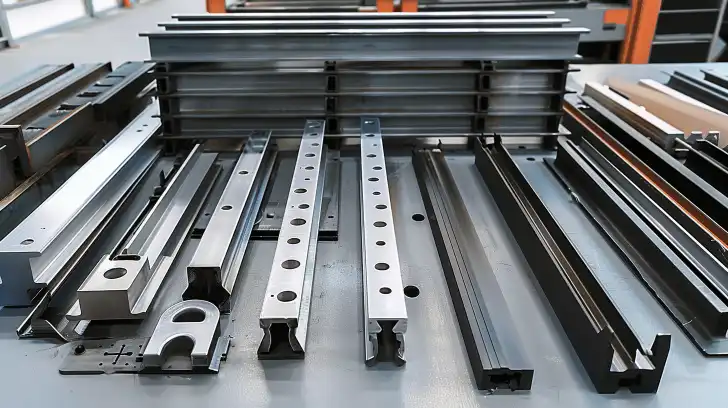
프레스 브레이크는 어떻게 작동하나요?
프레스 브레이크 성형의 단계를 알면 정밀도와 계획이 가장 중요한 부분을 이해하는 데 도움이 됩니다. 각 단계는 부품의 최종 모양, 품질 및 효율성에 영향을 미칩니다.
1단계: 자료 준비하기
올바른 판금을 선택하는 것부터 시작하세요. 두께, 크기, 종류는 구부러지는 방식에 영향을 미칩니다. 판금이 평평하고 깨끗하며 긁힌 자국이 없는지 확인하세요. 이렇게 하면 구부리는 동안 오류를 방지하는 데 도움이 됩니다.
그런 다음 굽힘선 위치를 확인합니다. 이를 명확하게 표시하거나 자동화된 경우 CNC 시스템에 디자인을 로드합니다.
2단계: 프레스 브레이크 설정하기
원하는 구부림 반경과 소재에 따라 올바른 펀치와 다이를 설치합니다. 제대로 정렬되고 제자리에 단단히 고정되었는지 확인합니다.
뒷면 게이지를 조정합니다. 구부러진 부분이 올바른 위치에 놓이도록 금속을 배치합니다. CNC 시스템의 경우 부품 치수와 굽힘 각도를 제어 장치에 입력합니다.
3단계: 판금 위치 지정
시트를 뒷면 게이지에 대고 놓습니다. 게이지가 각 구부러짐에 대해 올바른 위치에 시트를 고정합니다. 작업자가 정렬을 확인하여 시트가 평평하고 똑바로 놓여 있는지 확인합니다.
일부 프레스 브레이크는 클램핑 시스템을 사용하여 시트를 제자리에 고정합니다.
4단계: 금속 구부리기
모든 것이 설정되면 램이 펀치를 다이 안으로 내립니다. 다이에 따라 이 동작은 금속을 V 또는 U 모양으로 만듭니다.
설정된 깊이 또는 각도에 도달하면 프레스가 멈춥니다. CNC 기계는 센서와 소프트웨어를 사용하여 이를 실시간으로 모니터링합니다.
5단계: 결과 검사
구부린 후 부품을 확인합니다. 각도, 위치 및 치수를 측정합니다. 꺼져 있으면 다음 사이클 전에 프레스 브레이크 또는 후면 게이지를 조정합니다.
부품의 각 구부러진 부분에 대해 이 과정을 반복합니다. 다중 굽힘 부품의 경우 굽힘 사이에 시트를 다시 배치해야 할 수 있습니다.
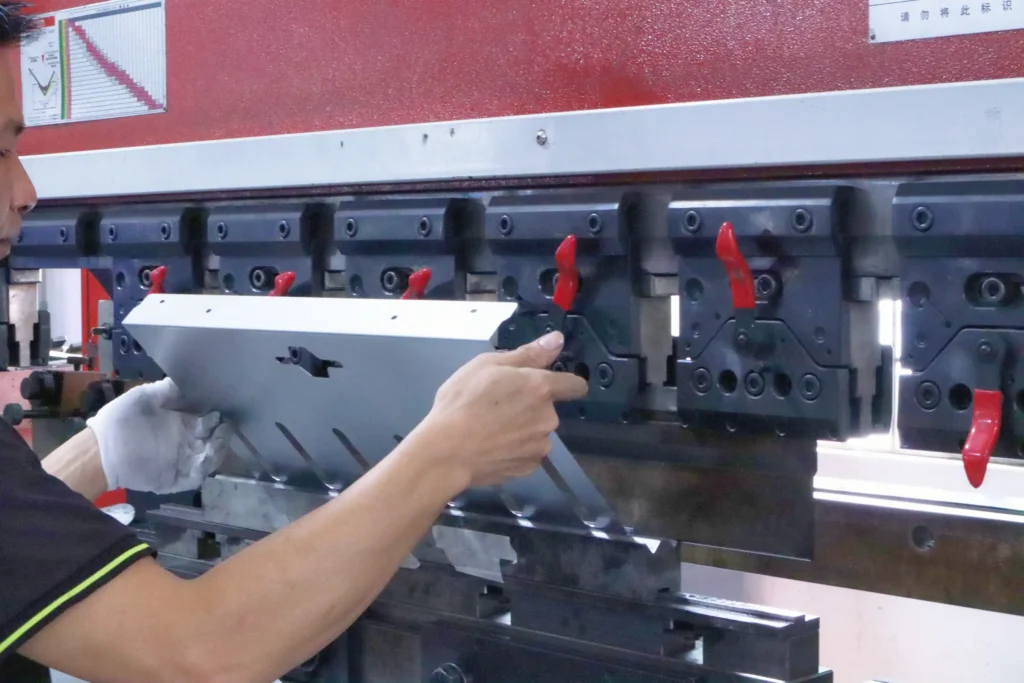
프레스 브레이크 성형에 사용되는 일반 재료
소재 선택은 굽힘 공정에 영향을 미칩니다. 금속마다 압력 하에서 다르게 작동합니다. 프레스 브레이크 성형에 사용되는 일상적인 소재를 살펴보겠습니다.
- 온화한 강철: 연강은 프레스 브레이크 작업에서 가장 많이 사용되는 소재입니다. 연강은 강하고 저렴하며 성형이 쉽습니다. 금이 가지 않고 구부러지며 모양이 잘 유지됩니다.
- 스테인레스 스틸: 스테인리스 스틸은 더 단단하고 부식에 더 강합니다. 연강보다 구부리려면 더 많은 힘이 필요합니다.
- 알류미늄: 알루미늄은 가볍고 부식에 강합니다. 쉽게 구부러지지만 무리하게 사용하면 금이 가기 쉽습니다.
- 구리 및 황동: 구리와 황동은 더 부드럽고 장식적인 느낌을 줍니다. 잘 구부러지지만 조심스럽게 다루지 않으면 긁히거나 변형될 수 있습니다.
- 아연 도금 강판: 아연도금 강철은 녹에 강한 아연 코팅이 되어 있습니다. 연강처럼 구부러지지만 코팅이 손상되지 않도록 깨끗한 도구가 필요합니다.
프레스 브레이크의 종류
각 프레스 브레이크 유형은 다양한 제조 요구 사항에 따라 고유한 장점이 있습니다. 비교 방법은 다음과 같습니다.
기계식 프레스 브레이크
기계식 프레스 브레이크는 전기 모터로 구동되는 플라이휠을 사용합니다. 플라이휠이 작동하면 램을 아래로 구동하여 금속을 구부립니다.
이 기계는 빠르고 강력합니다. 단순하고 반복적인 작업에 적합합니다. 하지만 스트로크 중에는 제어력이 떨어지고 동작이 시작되면 더 많은 조정이 필요합니다.
유압식 프레스 브레이크
유압 프레스 브레이크는 유압 실린더를 사용하여 램을 움직입니다. 이를 통해 속도와 힘을 더 잘 제어할 수 있습니다.
기계식보다 느리지만 더 안전하고 다용도로 사용할 수 있습니다. 더 두꺼운 재료를 다루고 더 일관된 굴곡을 만들 수 있습니다. 대부분의 제작 공장에서 널리 사용됩니다.
공압 프레스 브레이크
공압식 프레스 브레이크는 공기압을 이용해 램에 동력을 공급합니다. 빠르고 조용하지만 다른 유형만큼 강력하지는 않습니다.
얇은 재료나 작은 부품에 자주 사용됩니다. 대량의 저강도 작업에 적합합니다.
전기 프레스 브레이크
전동 프레스 브레이크는 유압이나 플라이휠 대신 서보 모터를 사용합니다. 높은 정확도, 에너지 효율, 낮은 유지보수 비용을 제공합니다.
엄격한 공차가 필요한 부품에 이상적입니다. 빠른 설정과 조용한 작동으로 청결한 환경이나 첨단 기술 환경에서 인기가 높습니다.
하이브리드 프레스 브레이크
하이브리드 프레스 브레이크는 유압과 전기 시스템을 결합한 제품입니다. 유압의 힘으로 전기 드라이브를 제어할 수 있습니다.
이를 통해 더 부드러운 움직임, 더 빠른 사이클, 더 나은 에너지 사용을 제공합니다. 정밀도와 파워가 필요한 매장을 위한 현대적인 선택입니다.
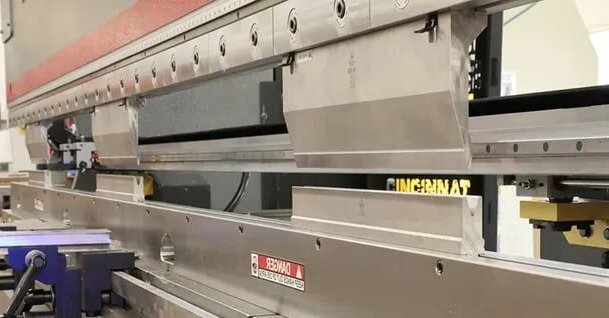
브레이크 포밍을 누릅니다: 장단점
프레스 브레이크 성형이 널리 사용되는 데에는 이유가 있습니다. 많은 부품에 적용 가능하며 정확한 결과를 얻을 수 있기 때문입니다. 하지만 다른 공정과 마찬가지로 단점도 있습니다. 프레스 브레이크 성형의 장점과 단점을 명확하게 살펴보겠습니다.
장점
- 정도: 프레스 브레이크는 굽힘 각도와 부품 치수를 엄격하게 제어할 수 있습니다. CNC 모델은 매번 동일한 결과를 얻을 수 있습니다.
- 다재: 다양한 재료와 두께로 작업할 수 있습니다. 단순한 부품이나 여러 개의 구부러진 복잡한 모양을 만들 수 있습니다.
- 확장성: 일회성 프로토타입 또는 대량 생산에 적합합니다. 한 번 설정한 파트를 쉽게 반복할 수 있습니다.
- 깔끔한 마감: 자르거나 거친 모서리 없이 재료를 구부립니다. 종종 추가 마감 단계가 필요하지 않습니다.
- 다양한 툴링: 다양한 각도, 반경 및 프로파일을 위한 다양한 펀치 및 다이 모양.
단점
- 설정 시간: 특히 맞춤형 부품의 경우 첫 설정에 시간이 걸립니다. 도구 변경 및 정렬이 느려질 수 있습니다.
- 스프링백: 구부린 후 금속이 원래 모양으로 돌아가려고 할 수 있습니다. 각도를 조정하여 이 문제를 해결해야 합니다.
- 모양에 대한 제한: 매우 복잡하거나 닫힌 프로파일을 만들 수 없습니다. 스트로크당 직선 굽힘만 가능합니다.
- 재료 제한: 일부 금속은 굽힘 반경이 너무 빡빡하면 금이 가거나 휘어질 수 있습니다.
- 숙련된 운영 필요: 정밀 절곡에는 낭비를 방지하기 위해 숙련된 작업자 또는 고급 CNC 시스템이 필요합니다.
포밍 기술 및 방법
구부리는 방법에 따라 결과가 달라질 수 있습니다. 다른 방법은 힘을 덜 사용합니다. 각각의 작동 방식을 알면 자신의 파트에 적합한 방법을 선택하는 데 도움이 됩니다.
에어벤딩
에어 벤딩이 가장 일반적인 방법입니다. 펀치는 바닥에 닿지 않고 금속을 다이에 밀어 넣습니다.
금속의 가장자리만 다이에 접촉합니다. 구부러지는 각도는 펀치가 얼마나 깊이 들어가느냐에 따라 달라집니다. 이 방법은 힘을 덜 사용하고 각도를 유연하게 조정할 수 있습니다. 그러나 스프링이 더 많이 되돌아오므로 보정이 필요합니다.
하단 굽힘
하단 벤딩은 시트를 다이의 바닥으로 밀어 넣습니다. 펀치는 금형 벽과 베이스에 닿을 때까지 금속을 누릅니다.
이렇게 하면 각도를 더 잘 제어하고 스프링백이 적습니다. 하지만 에어 벤딩보다 더 많은 힘이 필요하며 펀치와 다이 세트가 일치해야 합니다.
코이닝
주조는 매우 강한 힘을 사용하여 펀치를 재료 깊숙이 누릅니다. 금속이 다이 모양으로 압착됩니다.
이 방법은 가장 정밀하게 구부릴 수 있고 스프링백이 가장 적습니다. 하지만 공구가 더 빨리 마모되고 더 많은 에너지를 사용합니다. 엄격한 공차가 필요할 때 사용됩니다.
헤밍 및 시밍
헤밍 시트를 접어서 깔끔하고 둥근 가장자리를 만들고, 시밍은 접힌 가장자리가 있는 두 시트를 결합합니다.
이러한 기술은 다음에서 자주 사용됩니다. 인클로저, 문 또는 안전 덮개. 일반적으로 에어 벤드 또는 하단 벤드를 따릅니다.
오프셋 및 스텝 벤드
한 번의 스트로크로 두 각도에서 굽힘을 오프셋하여 Z 모양을 만듭니다. 스텝 벤드는 벤드 사이에 평평한 영역을 형성합니다.
다음에서 사용됩니다. 괄호클립 또는 여유 공간이 필요한 부품을 제거합니다. 깨끗한 결과를 얻으려면 특수 도구가 필요할 수 있습니다.
프레스 브레이크 성형의 과제와 고려 사항
신뢰할 수 있는 기계와 적합한 재료가 있더라도 금속을 구부리는 것이 항상 쉬운 것은 아닙니다. 생산을 원활하고 정확하게 유지하려면 이러한 문제를 관리해야 합니다.
스프링백
스프링백은 금속이 구부러진 후 원래 모양으로 돌아가려고 할 때 발생합니다. 압력이 해제되면 구부러진 부분이 약간 열립니다.
강도가 높은 금속이나 날카로운 구부러짐에서 더 두드러집니다. 이 문제를 해결하기 위해 작업자는 종종 약간 과도하게 구부리거나 코인을 사용합니다. 반복 가능한 결과를 얻으려면 정확한 보정이 핵심입니다.
머티리얼 가변성
사양이 같더라도 모든 시트가 똑같이 구부러지는 것은 아닙니다. 두께, 결 방향 또는 경도의 작은 변화가 굽힘에 영향을 미칠 수 있습니다.
이로 인해 각도가 일정하지 않거나 뒤틀림이 발생할 수 있습니다. 배치를 테스트하고 설정을 조정하면 오류를 줄이는 데 도움이 됩니다.
툴링 선택 및 마모
올바른 펀치와 다이를 선택하면 벤딩 정확도와 부품 품질에 영향을 미칩니다. 불일치는 균열, 고르지 않은 굽힘 또는 공구 손상으로 이어질 수 있습니다.
시간이 지나면 공구는 마모되고 날카로움을 잃게 됩니다. 마모된 공구는 모서리와 각도가 좋지 않습니다. 정기적인 점검과 교체가 필요합니다.
머신 보정 및 설정
프레스 브레이크는 적절한 캘리브레이션이 필요합니다. 램이 잘못 정렬되거나 백 게이지가 느슨하면 중심을 벗어난 굴곡이나 각도 이동이 발생할 수 있습니다.
특히 소량 배치나 복잡한 부품의 경우 설정 시간이 길어지면 생산 속도가 느려질 수 있습니다. CNC 시스템이 도움이 되지만 여전히 숙련된 입력이 필요합니다.
다른 금속 성형 기술과의 비교
올바른 선택 성형 방법 프로젝트의 요구 사항에 따라 다릅니다. 다른 일반적인 금속 성형 기술과 비교하여 속도, 비용 및 유연성 측면에서 브레이크 성형의 장점은 다음과 같습니다.
| 기술 | 강점 | 제한사항 | 모범 사용 사례 |
|---|---|---|---|
| 프레스 브레이크 성형 | 정확한 벤딩, 맞춤형 부품에 대한 유연성, 낮은 설치 비용 | 대용량의 경우 느리고 직선 굽힘으로 제한됨 | 프로토타입, 브래킷, 인클로저 |
| 롤 성형 | 긴 부품을 위한 고속, 일관된 출력 | 높은 툴링 비용, 짧거나 복잡한 부품에 적합하지 않음 | 긴 패널, 레일, 구조 채널 |
| 스탬핑 | 빠른 생산, 절단과 성형 결합 | 고가의 금형, 고정된 디자인으로 제한 | 세부 부품의 대량 생산 |
| 접는 기계 | 컷아웃 근처의 굴곡을 깔끔하게 처리하고 표면 자국 최소화 | 제한된 복잡성, 프레스 브레이크보다 느린 속도 | 대형 도어, 패널, 공차가 엄격한 부품 |
| 수동 벤딩 | 저렴한 비용, 기계 필요 없음 | 정확도가 낮고, 반복이 불가능하며, 노동 집약적인 작업 | 간단한 부품, 수리, 일회성 프로토타입 제작 |
결론
프레스 브레이크 성형은 판금 절곡을 위한 안정적이고 유연한 방법입니다. 다양한 소재와 함께 작동하고 다양한 부품 설계를 지원하며 소량 및 대량 생산 모두에서 우수한 정밀도를 제공합니다. 올바른 도구, 설정 및 기술을 사용하면 일관된 고품질의 결과를 얻을 수 있습니다.
맞춤형 판금 부품에 대한 도움이 필요하거나 프레스 브레이크 성형이 프로젝트에 적합한지 결정하는 데 도움이 필요하십니까? 팀에 문의 지금 바로 문의하여 빠른 견적과 전문가 지원을 받으세요.
추가 자료:
금속 굽힘 기술 비교 – 출처 : 원먼로
자동화가 제조에 미치는 영향 – 출처 : 모션
안녕하세요, 저는 케빈 리입니다

지난 10년 동안 저는 다양한 형태의 판금 제작에 몰두해 왔으며 다양한 워크숍에서 얻은 경험에서 얻은 멋진 통찰력을 이곳에서 공유했습니다.
연락하세요

케빈 리
저는 레이저 절단, 굽힘, 용접 및 표면 처리 기술을 전문으로 하는 판금 제조 분야에서 10년 이상의 전문 경험을 갖고 있습니다. Shengen의 기술 이사로서 저는 복잡한 제조 문제를 해결하고 각 프로젝트에서 혁신과 품질을 주도하는 데 최선을 다하고 있습니다.

